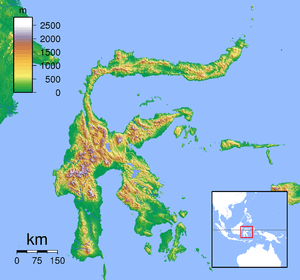Bontobahari
| Bontobahari | |
|---|---|
| Kecamatan and town | |
 Bontobahari Location in Sulawesi | |
| Coordinates: 5°31′31″S 120°21′35″E / 5.52528°S 120.35972°ECoordinates: 5°31′31″S 120°21′35″E / 5.52528°S 120.35972°E | |
| Country |
|
| Province | South Sulawesi |
| Regency | Bulukumba Regency |
| Time zone | WIB (UTC+7) |
Bontobahari or Bonto Bahari is a small town and kecamatan in South Sulawesi, Indonesia. The town is located on the south-eastern coast of Sulawesi on the Flores Sea and the surrounding area forms the Bontobahari Faunal Reserve, a protected area under conservation.
Economy
Bonto Bahari means "Land of the Sea"; it is located at sea level and the soil in area is said to be too thin to support agriculture.[1][2] It contains a series of fishponds which are owned by local villagers.[3] Bontobahari is noted for its Konjo or Kunjo boatbuilders, Konjo being a tribe which inhabit Bontobahari and surrounding areas of Kajang, Herlang and Bonto Tiro within the Bulukumba Regency.[4] In 1987 villagers built the Hai Marge and in December of that year, 13 people from Makassar sailed for northern Australia in it. The trip was a success and today this boat which was built in Bontobahari is located in the Darwin Museum.[5]
References
- ↑ John E. Fa, Donald G. Lindburg (1996). Evolution and ecology of macaque societies. Cambridge University Press. p. 46. ISBN 0-521-41680-9.
- ↑ Gibson, Thomas (2005). And the sun pursued the moon: symbolic knowledge and traditional authority among the Makassar. University of Hawaii Press. ISBN 0-8248-2865-8.
- ↑ Masayoshi Shigeta, Yntiso D. Gebre (2005). Environment, livelihood and local praxis in Asia and Africa. Center for African Area Studies, Kyoto University. p. 20.
- ↑ Gregerson, Marilyn (1993). Ritual, belief, and kinship in Sulawesi. Volume 31 of Summer Institute of Linguistics and the University of Texas, International Museum of Cultures. p. 100. ISBN 0-88312-621-4.
- ↑ Stephenson, Peta (2007). The outsiders within: telling Australia's indigenous-Asian story. UNSW Press. p. 28. ISBN 0-86840-836-0.